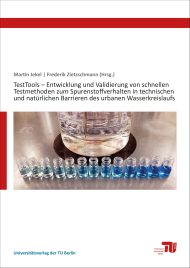TestTools – Entwicklung und Validierung von schnellen Testmethoden zum Spurenstoffverhalten in technischen und natürlichen Barrieren des urbanen Wasserkreislaufs
Editor: Frederik Zietzschmann, Martin Jekel

Format: 17,0 x 24,0 cm
Publishing year: 2018
The joint project “TestTools” studied the applicability of various test methods for the behaviour of organic micro-pollutants in different natural and technological barriers. The following short summary gives an overview on the most relevant results.
Dosage of powdered activated carbon (PAC) in laboratory experiments should be conducted by using stock suspensions in pure water which have been subject to sufficient wetting and degassing, in combination with laboratory pipettes; during stock suspension preparation, the PAC water and ash contents can be determined with relatively little additional effort. Upon dosage, mixture should be accomplished with one-dimensional horizontal lab shakers. The surrogate parameter of UV254nm absorption allows for predicting organic micro-pollutant removals independent of the PAC product in most cases. The novel initialization of the equivalent background compound model (EBCM) via water quality parameters (e.g. DOC) was validated. Methyl orange is suitable as a defined surrogate for the simulation of background organics adsorption competition. UV254 allows for monitoring and controlling continuously operated pilot/large-scale PAC plants. A lab batch procedure is recommended for projections of organic micro-pollutant removals on full-scale PAC recirculation plants.
Rapid small-scale column tests (RSSCTs) could be confirmed as a suitable method for fast and reliable testing of granular activated carbon (GAC) by comparisons with large-scale data, despite some restrictions. Large RSSCTs reduce these restrictions but induce substantially increased efforts. GAC batch tests are only partly suitable. Integral breakthrough curves are subject to reduced fluctuations compared to direct (“current”) breakthrough curves. Depictions over specific throughputs of water quality parameters (from size exclusion chromatography of the DOC) allow for alignments of breakthrough curves obtained in different types of waters. Surrogate parameters such as UV254 are only little useful for breakthrough predictions of organic micro-pollutants (usefulness decreasing with increasing adsorbability). The usefulness of artificial surrogates should be further clarified.
Ozonation lab tests in batch and semi-batch setups produce comparable results regarding organic micro-pollutant eliminations, but they have different (dis)advantages with respect to practical implementation. The impacts of suspended solids on ozoneinduced organic micro-pollutant eliminations are small and only relevant at concentrations greater 20 mg/L dry mat-ter. The influences of temperature and pH are also small or non-existent; however, they affect the established ozone consumption profiles. UV254 allows for good predictions of organic micro-pollutant eliminations. Bromate formation was partly different in batch and semi-batch setups; bromate and NDMA formations are generally over-estimated compared to pilot or full-scale plants. The organic micro-pollutant and UV254 eliminations at 18 domestic wastewater treatment plants were determined; the established data can be used for reference applications. Internal OH radical tracers were found in all 18 effluents, which can be used for assessing the OH radical exposure as well as for quality control purposes. Ozone exposure-/OH radical exposure-based modelling led to partly noticeable overestimations of organic micro-pollutant eliminations. The results of a survey demonstrated a predominantly very high knowledgeability on ozonation in relevant stakeholders. As post-treatment steps, the participants recommend filter systems, in particular granular activated carbon filters.
For natural/biological barriers like bank filtration or managed aquifer recharge, rapid laboratory test methods are only partly informative, because of the occurring complex processes in such systems. Recent findings highlight that even minor variations in oxygen availability or biologically available organic carbon can cause substantial differences of organic micro-pollutant eliminations. In addition to the chemical parameters, the composition of the micro-biocenosis has critical impacts on transformation rates. Overall, simple and rapid laboratory tests are not suitable for simulating highly complex underground processes. Only the transformation of substances which are well-degradable under oxic conditions can be reproduced relatively satisfactorily in small-scale lab columns.



